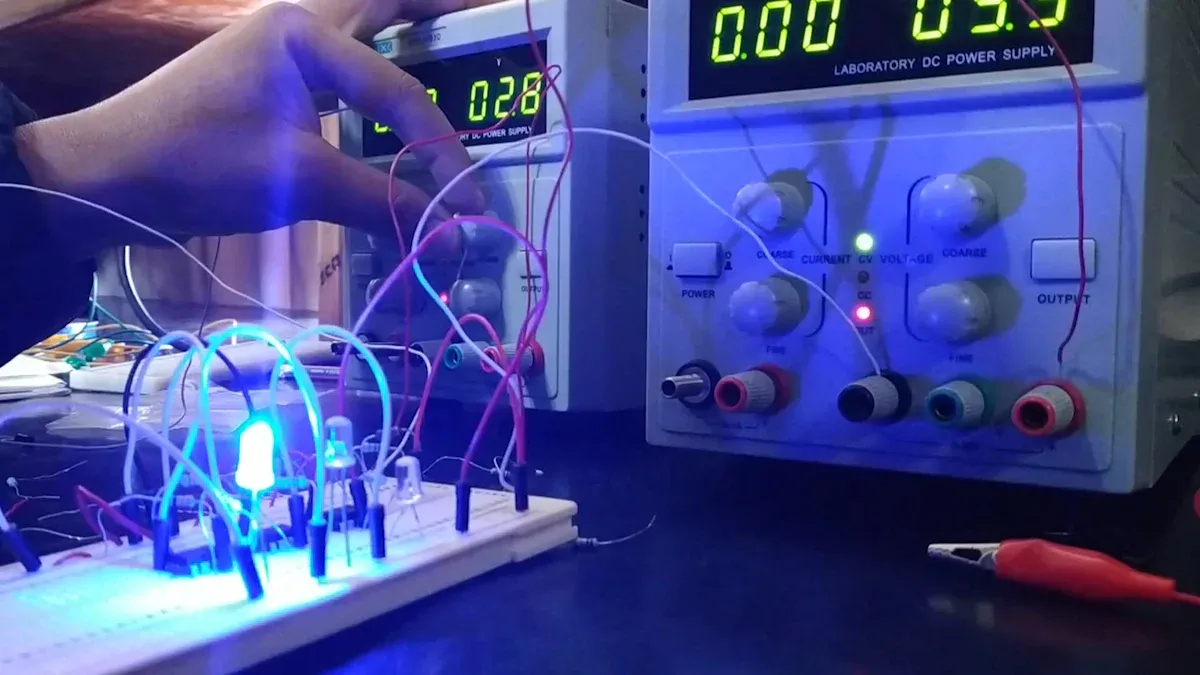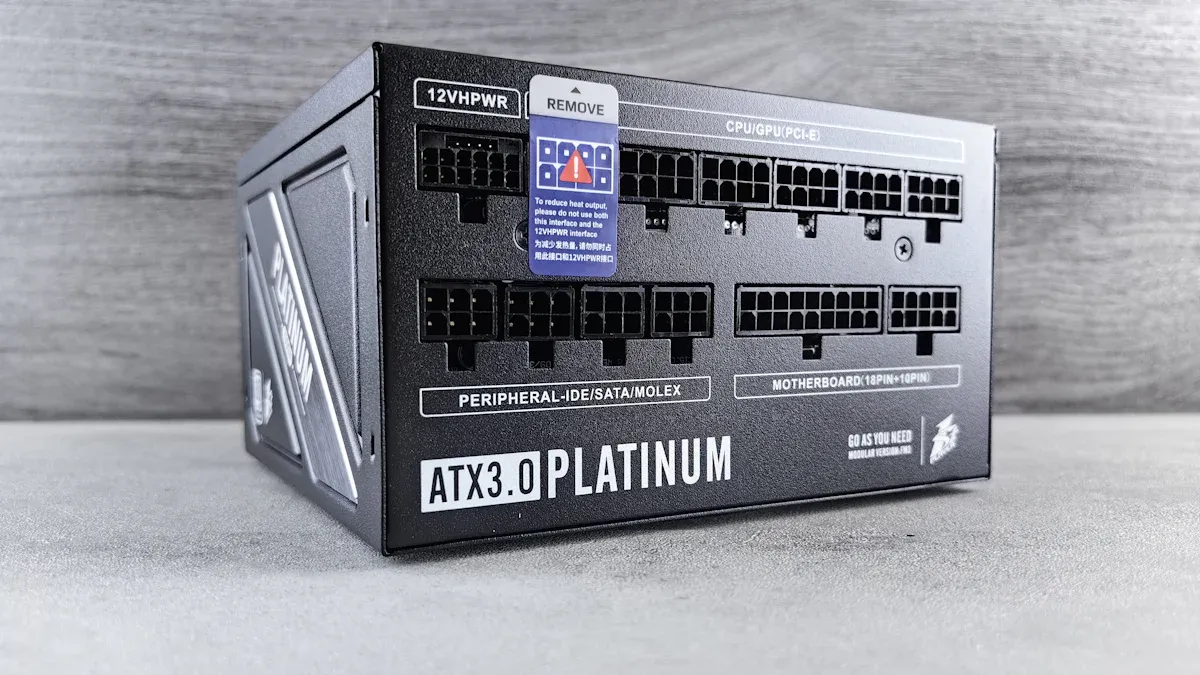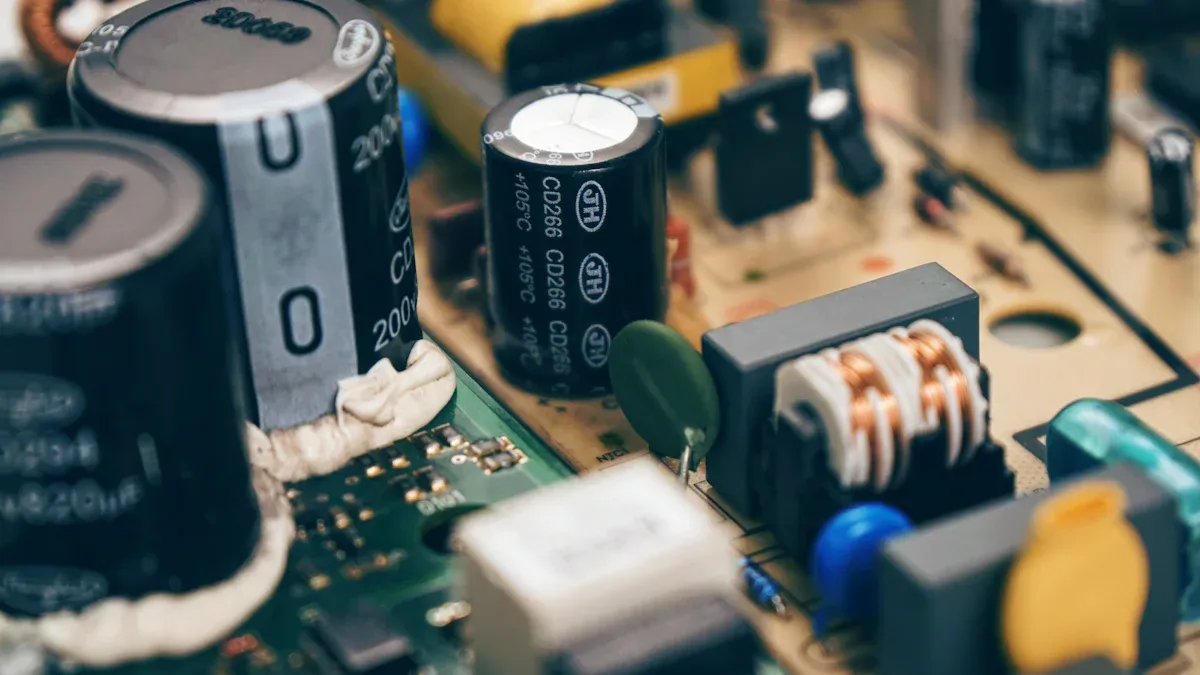What is the Difference Between Rectifiers and Power Supplies

Rectifiers, such as those in a rectifier power supply, convert alternating current (AC) into direct current (DC). This process is crucial because approximately 74% of household devices, including electric cars and HVAC systems, rely on DC power. However, converting AC to DC can result in up to 20% energy loss in DC devices. A rectifier power supply not only performs this conversion but also ensures controlled and reliable power delivery tailored to the needs of the devices. While rectifiers focus on transforming AC into DC, power supplies are designed to provide steady and safe power.
Key Takeaways
Rectifiers change alternating current (AC) into direct current (DC). This is needed for devices like phones and electric cars.
Power supplies do more than just convert AC to DC. They also control and steady the voltage to protect delicate electronics.
Rectifiers are simpler and used for things like charging batteries or welding. Power supplies are more advanced and used for steady power needs.
Pick a rectifier if you only need AC to DC conversion. Use a power supply if your device needs stable voltage.
New rectifiers and power supplies are better and save energy. Materials like silicon carbide make them work faster and use less power.
What is a Rectifier?

Definition and Function of a Rectifier
A rectifier is a device that changes alternating current (AC) into direct current (DC). This process, called rectification, is important for devices needing DC power. For instance, gadgets like phones and laptops use DC to work properly. Rectifiers help provide steady and reliable DC power from an AC source.
Rectifiers are often part of power supply systems. They are key in a rectifier power supply, which not only changes AC to DC but also ensures the output is stable for connected devices. The main difference between transformers and rectifiers is their job. Transformers adjust voltage levels, while rectifiers focus on turning AC into DC.
Components of a Rectifier
Rectifiers have several important parts, each with a specific role in the process. These include:
Transformer: Changes the AC voltage to the needed level before conversion.
Rectifier Circuit: Uses diodes to let current flow in one direction, converting AC to DC.
Filter Capacitor: Smooths out the DC voltage, making it more stable.
Voltage Regulator: Keeps the output voltage steady, even if the input changes.
For example, rectifier diodes are crucial for allowing current to flow in one direction. They must handle high currents to work well. Full-wave rectifiers, which use the whole AC cycle, are more efficient than half-wave rectifiers.
Component | Purpose |
|---|---|
Transformer | Changes the AC voltage to the needed level. |
Rectifier Circuit | Uses diodes to convert AC to DC by controlling current direction. |
Filter Capacitor | Smooths the DC voltage, reducing any bumps or fluctuations. |
Voltage Regulator | Keeps the output voltage steady, even with input changes. |
Types of Rectifiers
There are different types of rectifiers, each made for specific uses. The main types are:
Half-Wave Rectifiers: Use only half of the AC cycle. They are simple but less efficient.
Full-Wave Rectifiers: Use both halves of the AC cycle, making them more efficient.
Bridge Rectifiers: A type of full-wave rectifier with four diodes in a bridge shape. They are very efficient and common in power supplies.
Polyphase Rectifiers: Made for three-phase AC systems, often used in factories.
Over time, rectifiers have improved a lot. Early ones used mechanical parts like motor-driven switches. Later, vacuum tube rectifiers replaced these in the early 1900s. From 1909 to 1975, mercury-arc rectifiers were used for high-voltage systems. Today, modern rectifiers use advanced materials like silicon carbide for better performance.
Evidence Description | Time Period | Type of Rectifier |
|---|---|---|
Devices with motor-driven switches or commutators | Early 1900s | Mechanical rectifiers |
Vacuum tube rectifiers replaced mechanical ones | Early 1900s | Vacuum tube rectifiers |
Mercury-arc rectifiers used in HVDC systems | 1909 to 1975 | Mercury-arc rectifiers |
Vacuum tube diodes introduced for power circuits | April 1915 | Vacuum tube diodes |
Rectifiers are essential in today’s electronics. They efficiently change AC to DC, making them a key part of power supply systems.
Applications of Rectifiers
Rectifiers are important for many devices and industries. They change AC power into DC, which is needed for many tasks. Below are some common ways rectifiers are used.
Battery Charging
Rectifiers help charge batteries in phones, laptops, and cars. They turn AC from the grid into DC, which batteries need. This is common in electronics, vehicles, and factories.Electroplating
Industries like car-making and aerospace use rectifiers for electroplating. The steady DC current helps coat metal evenly. This makes surfaces strong and rust-resistant.Electrolysis
Rectifiers provide steady current for chemical reactions. These reactions are used to split water or extract metals. This is key for making hydrogen fuel or refining materials.Welding Equipment
Welding machines use rectifiers to keep power steady. This helps create strong and accurate welds during the process.
Here’s a table summarizing these uses:
Application | Description |
|---|---|
Battery Charging | Changes AC to DC for charging batteries in devices and vehicles. |
Electroplating | Gives steady DC for even metal coating in industries like aerospace. |
Electrolysis | Provides current for reactions like water splitting and metal refining. |
Welding Equipment | Keeps power stable for strong and precise welding. |
Rectifiers are crucial in today’s technology. They ensure reliable AC to DC conversion for many uses.
What is a Power Supply?
Definition and Function of a Power Supply
A power supply gives energy to run electronic devices. It changes electricity from a source, like a wall outlet, into the right type for your device. Many devices need DC instead of AC to work. A power supply makes this change and keeps the output steady, even if the input power goes up or down. This steadiness protects delicate electronics, like computers and medical tools, from harm caused by power spikes.
Regulated power supplies are very useful. They have voltage regulators that keep the output voltage steady, no matter how much power your device uses. This makes them great for jobs where accuracy and dependability are very important.
Fun Fact: Switching power supplies, invented in the 1950s, made devices more efficient and compact, leading to modern designs.
Components of a Power Supply
Power supplies have several parts, each with a job to do. These include:
Transformer: Changes the input voltage to the needed level.
Rectifier Circuit: Turns AC into DC, like in a rectifier power supply.
Filter Capacitor: Smooths the DC voltage to make it steady.
Voltage Regulator: Keeps the output voltage stable, even if the input changes.
Protection Mechanisms: Stops damage from too much voltage, current, or short circuits.
Noise Filter: Cuts down electrical noise for cleaner power.
Modern power supplies aim to save energy and reduce waste. For example, switching power supplies are small and efficient, making them perfect for portable gadgets.
Types of Power Supplies
There are different kinds of power supplies for various uses. Here are the main ones:
Linear Regulated Power Supply: Uses linear regulators to give steady voltage. It’s simple but wastes energy as heat.
Switching Power Supply: Converts power efficiently using high-speed switching. It’s small and light, great for modern devices.
Uninterruptible Power Supply (UPS): Provides backup power during outages and protects against surges. It’s vital for systems like data centers.
AC-DC and DC-DC Converters: Special power supplies for changing and controlling voltage in things like renewable energy systems and electric cars.
Power supplies have come a long way. From basic power strips in the 1960s to smart systems in the 1990s, they’ve become more efficient and reliable. Today, they’re essential for electronics, factories, and even medical tools.
Applications of Power Supplies
Power supplies are important for running devices in many industries. They make sure electronic systems get the right energy to work well. Below are some common ways power supplies are used.
Consumer Electronics
Power supplies help charge gadgets like phones, laptops, and game consoles. They change electricity from the grid into a safe form for devices. Without this, your devices might overheat or stop working.Industrial Automation
Factories use regulated power supplies to keep machines working smoothly. These supplies give steady voltage to robotic arms and conveyor belts. Linear regulated power supplies are often chosen for their dependability.Data Centers and High-Performance Computing
Data centers need strong power supplies for servers and storage systems. For example, the Modular Hardware System Common Redundant Power Supply (M-CRPS) provides up to 1800 W of power with 96% efficiency. Its small size and 80PLUS® Titanium certification make it great for AI and machine learning tasks.Medical Equipment
Hospitals use switching power supplies for tools like MRI machines and ventilators. These supplies are small and save energy, making them perfect for medical devices needing stable power.Renewable Energy Systems
Solar and wind energy systems rely on power supplies. They convert and control energy from these sources so it can be stored or used properly.
Feature | Description |
|---|---|
Product | Modular Hardware System Common Redundant Power Supply (M-CRPS) |
Power Output | 1800 W |
Form Factor | 60mm x 185mm |
Efficiency Certification | 80PLUS® Titanium |
Efficiency | Up to 96% |
Applications | High-performance computing, AI, ML |
Power supplies are key to modern technology. From switching power supplies at home to regulated ones in factories, they keep devices running safely and efficiently.
Rectifier vs Power Supply: Key Differences

Functional Differences
Rectifiers and power supplies have different main jobs. A rectifier changes AC into DC, a process called rectification. This is important for devices that need DC to work. For example, a bridge rectifier uses the whole AC cycle to make smoother DC with less ripple. This makes it great for tasks like running industrial machines or welding tools. A power supply, however, does more than just convert power. It also gives steady voltage and current to devices, often using a rectifier as part of its system.
Rectifiers are simpler but vary in how well they work. A half-wave rectifier only uses half of the AC cycle, creating a bumpy DC output. This simple design works for low-power items like basic chargers. On the other hand, a linear regulated power supply not only converts AC to DC but also keeps the voltage steady, even if the input changes. This is very important for delicate devices like medical tools and data centers.
Key Insight: Rectifiers convert AC to DC, while power supplies handle both conversion and regulation, ensuring devices get the exact energy they need.
Differences in Components
The parts inside rectifiers and power supplies show their different purposes. A rectifier usually has a transformer to lower voltage, diodes to convert AC to DC, and a filter capacitor to smooth the output. For example, bridge rectifiers use four diodes in a special setup to improve efficiency and stability.
Power supplies are more advanced. They include a transformer, voltage stabilizer, filters, and safety features to stop damage from power surges or short circuits. Modern power supplies may also have noise filters to reduce electrical interference, giving cleaner power. This complexity lets power supplies work in many areas, from home gadgets to factory machines.
Component/Application | Rectifier | Power Supply |
|---|---|---|
Primary Function | Changes AC to DC | Gives steady voltage and current |
Components | Transformer, diodes, filter capacitor | Transformer, stabilizer, filters, safety features |
Typical Applications | Charging batteries | Powering devices |
Differences in Applications
Rectifiers and power supplies are used for different things. Rectifiers are common in battery charging, electroplating, and welding. For instance, they give steady DC for chemical processes like electrolysis or for making strong welds in factories. Bridge rectifiers, with their stable output, are useful in power adapters and industrial systems.
Power supplies are made to power many kinds of devices. They are key in electronics, helping gadgets like laptops and gaming consoles run safely. In factories, regulated power supplies keep machines working by giving consistent voltage. Uninterruptible power supplies (UPS) also provide backup power during outages, protecting important systems like data centers.
Did You Know? Switching power supplies are small and very efficient. They save energy and are perfect for modern portable devices, changing how electronics are powered.
Examples of Rectifier Power Supply Usage
Rectifier power supplies are important for many devices and industries. They change AC into DC to give the right type of power. Below are examples of how rectifiers are used.
Household Electronics
Everyday devices like phone chargers and LED lights need DC power. Rectifiers inside adapters change AC from outlets into DC for gadgets. Without this, devices might not work or could get damaged.Electric Vehicles (EVs)
EVs use rectifiers to charge their batteries. Charging stations convert AC into DC for steady power. Good rectifiers help charge faster and reduce energy loss.Industrial Machinery
Factories use rectifiers for machines and equipment. Processes like electroplating and electrolysis need stable DC power. Rectifiers provide this current for reliable results.Renewable Energy Systems
Solar panels and wind turbines make DC electricity. Rectifiers help store this energy in batteries or use it for DC devices. They ensure the energy works for different needs.Welding Equipment
Welding machines need stable DC power from rectifiers. This helps make strong and accurate welds. Rectifiers are key for construction and car repairs.
Tip: A rectifier changes AC to DC, while a power supply also controls and delivers power.
These examples show how rectifiers support modern technology. From homes to factories, they keep devices safe and working well.
Can Rectifiers and Power Supplies Replace Each Other?
When Rectifiers Can Replace Power Supplies
Sometimes, rectifiers can do the job of power supplies. This works if all you need is to change AC to DC without extra features like voltage control. For example, rectifiers are great for charging batteries in flashlights or small gadgets. These tasks don’t need exact voltage, so rectifiers are cheaper and work well.
Rectifiers are also useful with uneven loads. For instance, they are used in small backup generators. These generators power systems in tough places like factories, submarines, or mobile hospitals. In these cases, rectifiers handle high currents and reduce voltage problems. This protects sensitive devices and makes rectifiers a good choice for some industrial and military uses.
Tip: If your system only needs AC to DC conversion and no strict voltage control, a rectifier might be better.
When Power Supplies Can Replace Rectifiers
Power supplies can take over when devices need steady and safe power. For example, medical tools and data servers need stable voltage to work properly. A power supply keeps the voltage steady, even if the input changes. It also protects against power surges or short circuits.
In hybrid-electric systems, power supplies are very important. They use DC/DC converters to manage high-voltage grids from batteries. This is key for electric cars and renewable energy systems. Unlike rectifiers, power supplies have extra features like noise reduction and better efficiency. These make them perfect for modern, high-tech devices.
Did You Know? Switching power supplies are small and save energy. They are great for portable gadgets and green energy systems.
Problems with Replacing Rectifiers and Power Supplies
Switching rectifiers and power supplies isn’t always easy. Rectifiers don’t have the advanced features of power supplies, like voltage control. This makes them unsuitable for devices needing precise power. For example, flyback power supplies lose efficiency due to parts like transformers. This shows how important good design is for power supplies.
On the other hand, power supplies can’t always replace rectifiers in factories. Power electronic rectifiers are needed for handling high currents and voltage changes. Using power supplies instead could cause problems or waste energy. Also, power supplies cost more and are more complex, which isn’t worth it for simple AC to DC tasks.
Note: Picking between a rectifier and a power supply depends on what your system needs. Think about voltage control, efficiency, and cost before deciding.
Rectifiers and power supplies are important for powering devices today. A rectifier changes AC into DC, which many devices need to work. A power supply does more—it changes, controls, and delivers steady power to keep devices safe and efficient.
Quick Comparison:
Functionality: Rectifiers change AC to DC. Power supplies also control and stabilize power.
Parts: Power supplies have extra features like voltage control and safety tools, unlike rectifiers.
Uses: Rectifiers are great for charging batteries and welding. Power supplies are better for delicate electronics and factory machines.
Remember: Rectifiers and power supplies do different jobs. They work well together but can’t fully replace each other. Knowing their roles helps you pick the right one for your needs.
FAQ
What does a rectifier do?
A rectifier changes alternating current (AC) into direct current (DC). This is important for devices like phones, laptops, and electric cars that need DC power to work.
Can a power supply function without a rectifier?
No, most power supplies need a rectifier. The rectifier changes AC into DC, which the power supply adjusts and sends to the device.
How are rectifiers and power supplies different in complexity?
Rectifiers are simpler and only change AC to DC. Power supplies are more advanced, with parts like voltage regulators to keep power steady and safe.
Are rectifiers good at saving energy?
Rectifiers can lose some energy when changing AC to DC. Newer rectifiers, made with materials like silicon carbide, are better at saving energy and work more efficiently.
Why do sensitive devices need power supplies?
Power supplies give steady power and protect devices from sudden changes. This keeps things like medical tools and computers working safely and properly.
See Also
Distinguishing Communication Power Supplies From Standard Options
Essential Insights Into Features of Telecom Power Supplies
Comprehending Global Standards for Communication Power Supplies
An Introductory Guide to Telecom Power Supply Systems
Investigating Amperage Requirements for Communication Power Supplies
CALL US DIRECTLY
86-13752765943
3A-8, SHUIWAN 1979 SQUARE (PHASE II), NO.111, TAIZI ROAD,SHUIWAN COMMUNITY, ZHAOSHANG STREET, NANSHAN DISTRICT, SHENZHEN, GUANGDONG, CHINA

